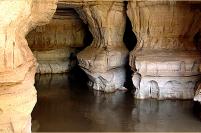- Thu, 05/24/2012 - 20:55
- 0 Comments
- Sof Omar cave, located in Bale Ethiopia, is one of the most spectacular and extensive underground cave systems in the world.
- It is formed by the Wabi River as it changed its course in the distant past and carved out a new channel through limestone foothills
- The cave, which is named after saintly Sheikh Sof Omar, is an important Islamic Shrine.
(From UNESCO). Sof Omar is one of the most spectacular and extensive underground caverns in the world. Formed by the Wabi River as it changed its course in the distant past and carved a new channel through limestone foothills, the Sof Omar cave system is an extraordinary natural phenomenon of breathtaking beauty.
Here the Wabi River vanishes into this giant underground world with its arched portals, high eroded ceilings, and deep, vaulted echoing chambers. These caves, now an important Islamic shrine named after the saintly Sheik Sof Omar Ahmed, who took refuge here many centuries ago (around early 11th century AD), have a religious history that predates the arrival of the Muslims in Bale — a history calibrated in thousands, not hundreds, of years.
The traditional belief of this part of Africa revolved around spirit worship and ghost cults in which the most powerful supernatural beings were believed to attach themselves to age-old trees, boulders rocks, and, inhabit caves which became place of veneration where prayers were offered up and sacrifices made. Even today, in this Sof Omar cave system and catacombs there are so many signs of the persistence of such African traditional beliefs and practices. Ever since the coming of the saintly Sheik Sof Omar Ahmed and through its long period of existence the religion Islam is now indigenized into this African traditional belief. For this part of Africa Islam has now become a culture in a unique way and not only a religion.
The approach to the caves is made through the tiny village of Sof Omar, perched on the cliffs above the Wabi River. To the rear of the village is a dark, gaping crevice down which a precipitous narrow footpath winds to the floor of the first cave. The total length of the Sof Omar cave system is about 16km and all along the cave system there are more than 40 main entrances and exits. Throughout the cave system, frequent crossings at the Wabi River are necessary. It is possible to explore the caves on foot, torches and other lighting are needed, since it is a very long and dark journey that can be accomplished with a help of map indicating the different ground references of the underground cave system.
In this realm of dry, cool caves nature has worked a marvel of architecture — soaring pillars of stone twenty metres (66 feet) high, flying buttresses, fluted arch ways, and tall airy vaults. Finally the river itself is reached, a sunless sea flowing through a deep gorge. Standing on a natural balcony of the last cavern near the roof of the outlet, one has a spectacular view of the river rushing along its course below.
The large central hall of Sof Omar, the 'Chamber of Columns' — so named after the colossal limestone pillars that are a dominant feature — is one of the highest of the cave system. At another part of the net work there is a small gap in the rock through which the river passes, about two-and-a- half meters (eight feet) wide, where a bridge can be made with driftwood to go across. The most direct route through the caves passes these and many other remarkable sights, and takes about three-and-a-half hours at good walking pace.
Inside the caves, the only living creatures are bats (which do not usually give trouble, if they are not deliberately disturbed), fish, and crustaceans. Crocodiles are to found in the river nearby but, fortunately seem to shun the caves themselves.
Holqa Sof Omar is a well preserved sacred place of worship, which has helped the preservation of the indigenous forest environment of the area and still serving as a natural habitat of the wildlife resources. The countryside around abounds with wildlife dik-dik and kudu, serval cat, rock hyrax, giant tortoises, snakes, and lizards as well as more than hundred species of birds.
Read more here
- 9580 reads







Post new comment